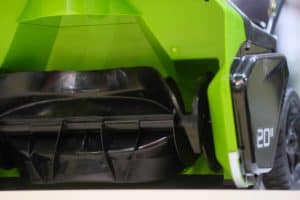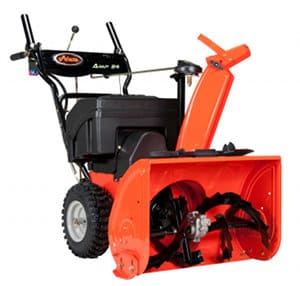 Snow removal is a $2 billion industry in the United States — and while we know that homeowners love the convenience of snow blowers and many sore backs are saved by their use, we wondered if there had been any recent progress to “green up” the much-beloved gas-guzzlers. Our research for this article revealed two trends in snow blowers that are worth watching.
Snow removal is a $2 billion industry in the United States — and while we know that homeowners love the convenience of snow blowers and many sore backs are saved by their use, we wondered if there had been any recent progress to “green up” the much-beloved gas-guzzlers. Our research for this article revealed two trends in snow blowers that are worth watching.
Battery Powered
The most significant environmental improvement in snowblowers is the upcoming release of a battery-powered model by Ariens called the AMP 24 Sno-Thro. Many snow blower aficionados will roll their eyes in response to this product because most electric snow blower engines are notoriously less powerful, and therefore less useful, than gas machines. However, the new Ariens is powered by a four horsepower brushless DC cordless electric motor energized by two 48-volt AGM Valve Regulated battery packs, which Ariens says matches the power and utility of its gas powered counterparts. Additionally, it is not tethered to an electric outlet via a cord.
“We have done quite a bit of testing on battery powered motors for our riding mower and it is clear that people would not be interested in a battery powered snow blower if it did not perform like a real mower,” says Ann Stilp, communications manager for Ariens. “In fact, the people who have tested our battery powered snow blower say it runs like a regular Ariens snow blower, but it runs so quietly that you
can hear the snow moving through the machine.”
 While we know of no outside testing group that has verified this claim, Peter Sawchuk, a program leader for Consumer Reports, says the technology is promising and that he has heard the Ariens snow blower’s performance is at least close to that of a gas powered snow blower. “We haven’t tested it yet, but it is certainly an alternative,” he said.
While we know of no outside testing group that has verified this claim, Peter Sawchuk, a program leader for Consumer Reports, says the technology is promising and that he has heard the Ariens snow blower’s performance is at least close to that of a gas powered snow blower. “We haven’t tested it yet, but it is certainly an alternative,” he said.
According to Stilp, the AMP 24 Sno-Thro includes the same features as the Ariens Compact Sno-Thro and will run for 45 to 60 minutes on a single charge depending on snow conditions. Charging the machine requires plugging it into a wall outlet.
Hybrid Engine
The next possible trend in snow blower engines is a series of hybrid snow blowers by Honda. The first of these was released by Honda in 2001. Since then Honda has come out with five small and mid-sized hybrid snow blowers.
The hybrid technology uses a gas-powered engine to power the snow blower’s apparatus — auger and impeller — which also charges the battery for an electric motor which handles forward propulsion.
However, while this technology seems promising — consider the popularity of Honda’s hybrid cars — these snow blowers are only available in Japan and it is unclear if Honda will introduce them to markets in North America. In addition, Sawchuk says this type of snow thrower — as well as the Ariens’ battery powered unit — is very expensive.
How to Mitigate the Impact of a Snow Blower
Besides traveling to Japan to buy Honda’s hybrid or waiting for Ariens’ electric powered machine to be released, there are things you can do right now to mitigate your gas machine’s pollution contribution, and in some cases, reduce its operating costs.
Two-stroke vs. Four-Stroke Engines : Simply stated, says Deb Berlin, a press officer for the EPA in its Washington D.C. headquarters,
a four-stroke engine will operate far more efficiently and with fewer emissions than a two-stroke (oil and gas mixed together) engine.
Additionally, says John Hoch, founder and CEO of online retailer Snow Blowers Direct, “Smaller two-stroke snow blowers are
generally weaker while the four-stroke snow blowers are higher performance.” He adds that most four-stroke engine snow blowers are also two-stage, which means they use an auger to draw snow in and break it up and then an impeller to send it out the chute at high velocity. Single-stage snow blowers have just an auger and are therefore less powerful.
Sawchuk agrees with Hoch’s analysis of the difference between two- and single-stage snow blowers, saying, “We found that two-stage snow blowers with self-propelled wheels in most cases, such as doing a driveway, are easier and far superior to use than a single-stage unit. Single-stage units also tend to use two-stroke engines, which are far dirtier than four-stroke engines. So step one is to use a two-stage, four-stroke snow blower, which generally start around $500. This is also the cost of a high-end single-stage snow blower.”
Hoch warns, though, that while most two-stage snow blowers have four-stroke engines, single-stage snow blowers can have either, so it is important to make sure you know what you are buying if you select a single stage snow blower and want it to have a four-stroke engine.
Sawchuk adds that two-stage snow blowers generally come with overhead-valve engines as opposed to the alternative L-head engines. Overhead-valve engines are significantly cleaner to run than L-head engines due to the fact that far less carbon adheres to the valves allowing them run more cleanly. They also represent a more efficient design than L-head engines.
All new two-stage snow blowers come with overhead valve engines, which Sawchuk says are nearly 75 percent cleaner burning than previous versions when other improvements are factored in. Since older model snow blowers are more likely to have the older L-head engines, it is better to resist the temptation to save money buying a secondhand machine. Consider sharing the cost of a better blower with a neighbor and sharing its use, meaning that both of you can use a better, faster, cleaner snow blower.
Fuel: According to both Berlin and Sawchuk, raw fuel spilled on the ground or even resting in the machine or a container can still emit pollutants via evaporation and is therefore a significant contributor to Hydrocarbons and Nitrogen Oxide (NOx) emissions.
Most people will burn excess fuel off in a snow blower or lawnmower at the end of the year by running the engine. This is generally done to prevent gasoline spoilage, which can affect performance the following year. However, it means you are emitting pollutants without garnering any benefit; gas stabilizers offer a better alternative. These are products that can be mixed with gas to keep it fresh (for up to three years, for some), and prevent varnish and gum deposits in the engine and fuel line, among other benefits.
Maintenance: The EPA recommends the following in order to reduce emissions, ensure efficient operation, and lengthen the life of your equipment:
- Always follow manufacturer’s guidelines for maintenance;
- Change the oil and clean or replace air filters regularly;
- Use the proper fuel/oil mix for two-stroke engines;
- Periodically tune up your equipment.
Additionally, you can reduce the time you use the snow blower by shoveling walkways and driveway edges and only using the snow blower for the larger areas. You can also maintain the blade of the auger and chute on your snow blower by using sprays and other products that lubricate and reduce the chance of snow sticking and making the time the machine has to run longer to get the job done.
Alternatives to Snow Blowers: Plug-in electric snow blowers don’t directly emit pollutants. However, according to Hoch and others, they are far less powerful than their gas counterparts and not well suited to larger jobs. They may be a good alternative for walkways and decks while a gas powered snow blower could be used for other areas. Some could also argue that the electric snow blower merely pushes the emissions upstream to the power generating plant.
Summary
Undoubtedly, using a snow blower is not as environmentally friendly as using a shovel. But there are other good reasons — including severe back injuries and heart attacks — that a shovel is not ideal either.
“Relatively speaking,” says EPA’s Deb Berlin, “snowblowers tend not to be as clean as other non-road equipment, but they are also used a lot less — some of the country doesn’t even use them at all and those that do only use them part of the year.”
Consumer Report’s Sawchuk, agrees, saying that the true impact of snow blowers in general depends on the region of the country and how much the machine is actually used. “Part of what is happening with the whole “Green” thing is that people are losing a sense of practicality,” he says. “If you live in snow country, you will use one quite a bit more, but generally speaking most snow blowers are used about ten times per year for an average of five hours. This is based on the amount of time the engine is actually running, not the time spent gassing up and getting ready and then cleaning up when you’re done. By contrast, a lawnmower is used about 30 times per year.”
Sawchuk adds that for a total usage of about five hours per year, you are likely using no more than a single gallon of gas. “How much bad stuff is in a gallon of gas?” he asks. “If you want to be environmentally conscious, don’t drive your SUV for a few miles each day because that SUV is using a swimming pool’s worth of gas each year compared to the one gallon used by a snow blower.”
In terms of the specific environmental impact of snow blowers, says Berlin, in 2009 gas powered snow blowers are projected to emit approximately 28,000 tons of Volatile Organic Compounds (VOCs) — these include CO and hydrocarbons — based on the EPA’s Non-Road Model. By comparison, walk-behind lawnmowers are projected to emit 109,000 tons of VOCs.
Nonetheless, given the severity of global warming and the desire to be environmentally conscious, selecting a two-stage, four-cycle snow blower may be your best option and your best value until viable alternatives come to market.
